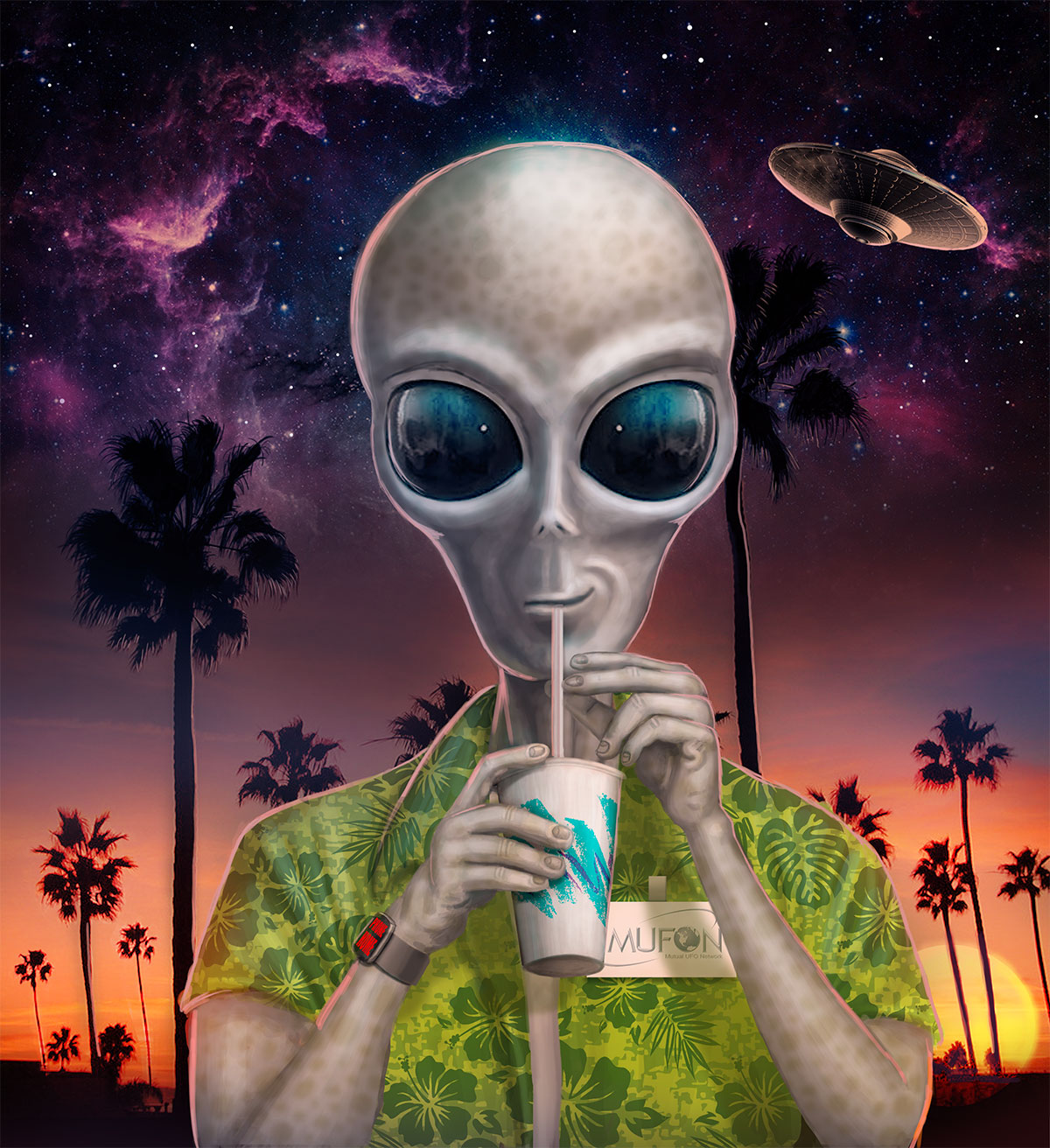
Joel Burton Gold is holding a little bottle of his CBD Light Energy oil, which he’s particularly proud of because it’s infused with moringa. The plant grows in India, Pakistan, Afghanistan and Bangladesh and has been used for thousands of years as an antioxidant, food source and aphrodisiac. The oil from it has been blended with perfume, hair-care products, engine lubricants and now CBD. Though the plant has been used for thousands of years, many in the west still haven’t heard of it.
“A lot of people are hearing about it now,” Gold says. “It works on cancer.”
Moringa is the most important element in Gold’s CBD oil, he says. It’s what sets his product apart from all the others on the market today.
“I really think aliens brought moringa to our planet,” Gold then tells me. “I really do.”
* * *
I wish I could say Gold’s statement surprised me. But it didn’t. Not even close. Spending three days at the Mutual UFO Network’s (MUFON) 2019 International UFO Symposium will do that to a person. Held July 26-28 at the Hotel Irvine, the symposium marked MUFON’s 50th anniversary as an organization dedicated to “the scientific study of UFOs for the benefit of humanity.”
MUFON members paid $329 for access to three days of presentations, lectures, films and the vendor room, whose many proprietors included Gold. (Non-members paid $349.) There were also “private speaker panels,” banquets, “field-investigator training” sessions and workshops (“How to Resist an Alien Abduction”) that cost extra.
Based in Irvine, over by John Wayne Airport, MUFON has for the past five decades dedicated itself to the rigorous study and investigation of unidentified flying objects. (In 2017, OC Weekly writer Taylor Hamby profiled MUFON and delved into its history.) The network trains its volunteer members (who are mostly in the U.S., but also reside in more than 40 other countries) to be investigators—to use impartial, rational means in the search for explanations for UFOs.
“I like to keep an objective view,” said Peter Derrick, a MUFON investigator who flew in from Saskatchewan to attend the symposium. “I try not to listen to ‘noise.’ If I want to investigate reports, I have to be objective. I’m not investigating sightings; I’m trying to investigate the reports of sightings. There are other reporting organizations, but MUFON is the most organized, most scientific. They take a rational approach. You have to have a scientific and systematic approach to getting the data. And they’re getting better at teaching people.”
Meredith Walako agreed. “People come here to listen to the speakers,” she said. “The MUFON people are more nuts-and-bolts-oriented.”
This sounds wonderful in theory—who doesn’t want to see recognized and accepted investigative standards in ufology? But it’s hard to read MUFON’s 50th-anniversary motto as anything other than a self-own: “50 Years of Never Giving Up.” Of course, I kept hearing from MUFON presenters and attendees the phrase “it’s getting better,” and there’s undoubtedly truth to that. But there’s also truth to the statement that since the first truly modern UFO sighting (Kenneth Arnold’s “flying saucers” near Mt. Rainier on June 24, 1947), there has been a complete lack of verifiable evidence that even one UFO was something otherworldly.
Yes, there are photographs, witness statements and reports. But nothing has added up to anything definitive. MUFON officials and investigators repeatedly mentioned throughout the symposium that “70 percent” of UFO reports are just “noise,” but if anything, that percentage seems low.
* * *
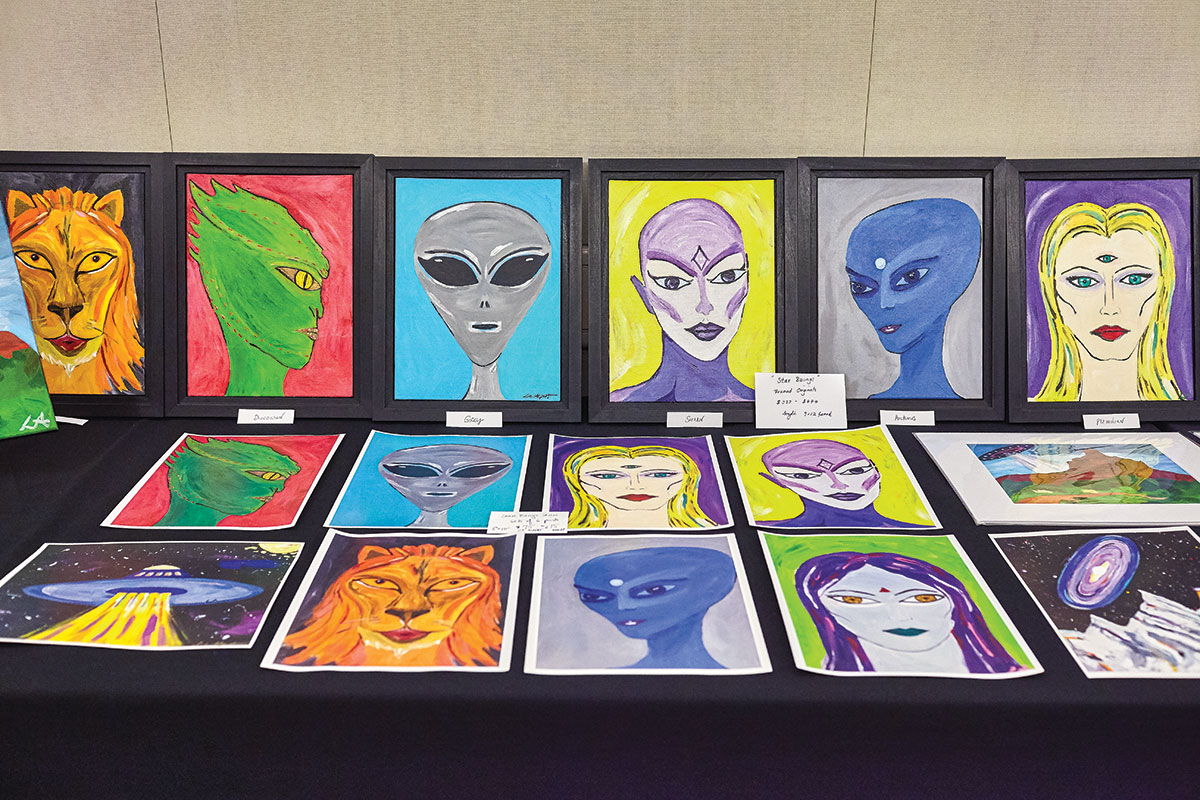
Nobody I heard or spoke to at the MUFON symposium expressed any disappointment that after all these decades, definitive proof remains elusive. If anything, they were hopeful—not that ironclad evidence would soon be found, but rather that the media were finally taking them seriously. In fact, more than one person I spoke with said that there were more reporters covering this MUFON symposium than others.
Though MUFON prides itself on the scientific approach, the vibe I got from the symposium was exactly the opposite: not only an earnest belief in the reality of extraterrestrial life, but also the absolute assurance that (1) such life regularly visits the Earth and (2) the U.S. government knows all about it. Actually, many people I saw and talked with were almost evangelical about the whole idea of UFOs.
“I like UFO shows because they’re so much fun,” said Liz Alpert, an artist from Sedona, Arizona, who traveled to the symposium to sell her jewelry and paintings. “It’s very upbeat. Everybody’s in a good mood.”
Alpert led OC Weekly art director Federico Medina and me over to the symposium’s art gallery. After she finished talking to us about her pieces, we crossed the room to where Julliena Okah was playing the violin. The musician was clad in a shimmery dress and standing in front of an array of her own artwork: flowery, almost spiritual paintings of flying saucers. She told us of her alien encounters in Tokyo; Honolulu; Las Vegas; and Nice, France. “All my paintings are based on my own experiences,” she said. “I wanted to show how I was connected to a power.”
Though others at the convention didn’t share the artists’ enthusiasm, they were no less passionate. A few feet from Alpert’s booth in the vendor room was another table covered in books, stickers and pamphlets, all advertising Alliesofhumanity.org.
“We’re the lone dissenting voice in the UFO community,” said Justin Kohn, who stood near the table. “There’s no evidence that the aliens are benevolent, here for our benefit. There’s no evidence that what they say is true. No serial killer is going to tell you that he’s a serial killer. They’re taking sperm and eggs out of people to create a hybrid race. It all makes perfect sense.”
* * *

It was hard to avoid the Saucerbrand.com setup in the vendor room. Putting an alien mannequin family on display, all wearing the latest Saucerbrand activewear, will do that.
“We have a product for everybody,” said David Salcedo, who started the company a year ago with his daughter and two sons. “It’s a good brand for this community. Something like this says a lot, but it’s not overkill. Our motto is ‘Believe . . . but believe in style.’”
Salcedo said the family used to watch alien documentaries on the History Channel. Eventually, his kids started making glow-in-the-dark logowear, so they formed a company. They sold out their supply at their first convention, AlienCon in Pasadena. The best-selling item was a black bomber jacket with the glow-in-the-dark saucer logo, Salcedo said, but they’re completely sold out of it—even online.
As I talked with the kids about recent customers, they recalled a woman in her 70s who bought a shirt for her dad. Another woman, who was in her 80s, bought a bomber jacket for herself.
“The church lady!” Salcedo says, remembering. “She was a reverend.”
* * *

Early on during the symposium, I noticed that the attendees were largely older white people. Most were men, but there were a significant number of women, too. This is common with UFO conventions, said Joseph O. Baker, an associate professor of sociology at East Tennessee State University.
“That is generally the case for the conferences, which is a particular form of intensive paranormal engagement,” Baker said in a July 29 email. “We did a survey of the 2010 International UFO Congress, and 95 percent of respondents were white. It also skewed toward older people. In terms of explanation, I think these are the people that have the time and money to devote to such pursuits. Also, because of this, at the conference level, you are more likely to see people who have high socioeconomic status compared to the general population of believers.”
But Baker also said that UFO believers as a whole don’t really skew anywhere in terms of race or age. In a March 2018 interview with New York Magazine, Baker further elaborated on the demographics of believers, who are mostly not the tinfoil-hat wearing yokels we see so often in pop culture.
“Men are more likely to believe, and people with lower levels of income are more likely to believe,” he said. “We don’t really find strong patterns by education, and if we do, there’s usually a slight positive effect. It’s not ignorance, and it’s not low education.”
Baker also noted something else, something I saw repeatedly during the MUFON symposium. “One of the other strongest predictors is not participating as strongly in forms of organized religion,” Baker told New York. “In some sense, there’s a bit of a clue there about what’s going on with belief—it’s providing an alternative belief system. If you look at religious-service attendance, there will be a strong negative effect there for belief in UFOs.”
* * *
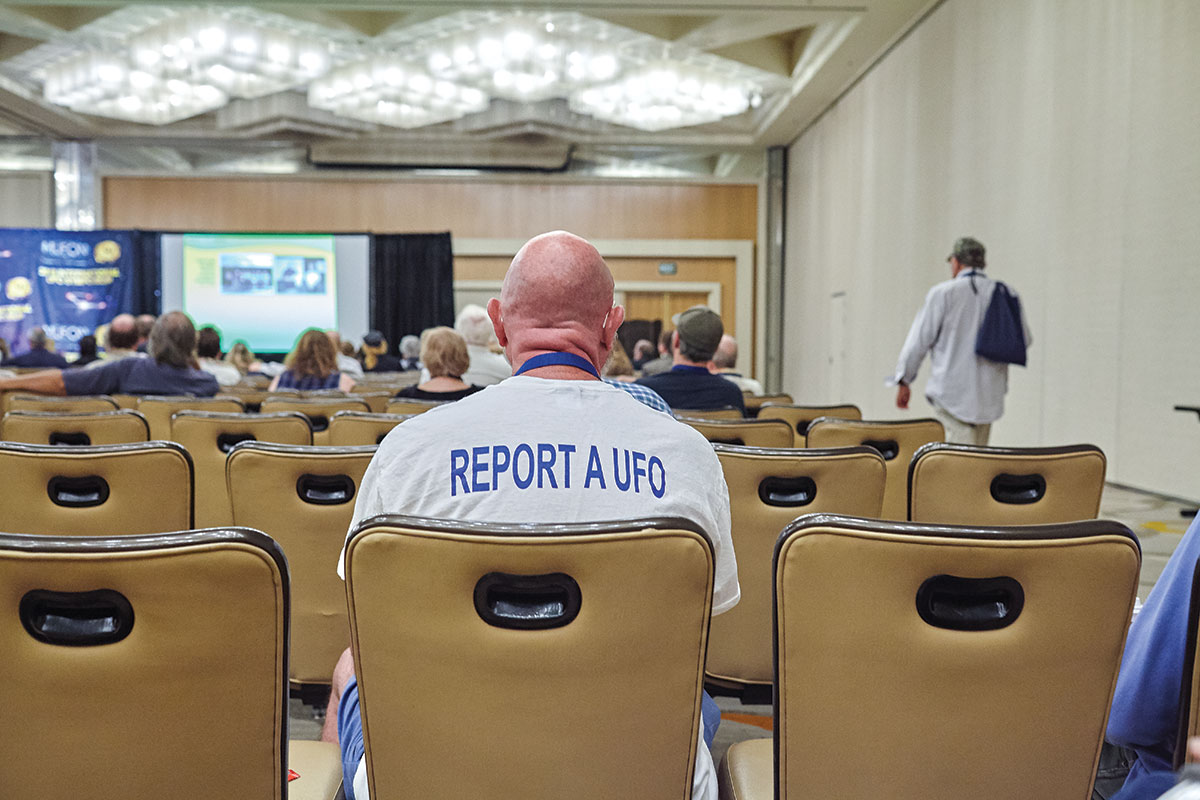
The most interesting, but ultimately frustrating presentation I attended at the symposium was Cheryl Costa’s lecture “21st Century UFO Statistics—Analysis and Updates.” Costa, who penned the “New York Skies” UFO column for the alt-weekly Syracuse New Times until that paper went under a few months ago, co-wrote (with her wife, Linda Miller Costa) the 2017 book UFO Sightings Desk Reference: United States of America 2001-2015. It analyzed data from upward of 120,000 UFO sightings collected by MUFON since 2001. The book made it into the Harper’s READINGS section in May 2018, with a table of all the UFO shapes that have been sighted, ordered from highest frequency (circle) to lowest (square).
“I don’t have case studies,” Costa told the 50 or so people in attendance. “I have big data. Instead of studying the ant, we decided to study the anthill.”
Costa has a fascinating life, in many ways even more fascinating than the UFO data and trends of which she spoke. During the Vietnam War (she was a man then; she transitioned in the 1990s), she served in the U.S. Air Force and worked on telephone poles. Later, she joined the U.S. Navy, serving on submarines. When she returned to civilian life, she got a job with Lockheed Martin. During her lecture, she said she spent her career doing “Tom Clancy stuff,” working in the “intelligence community” and on “electronic warfare”; she’s currently talking with an “LA producer” about a possible television show. As with many people I heard at the symposium, she pronounced the word nuclear as “nuke-ular.”
Costa said she and her wife started with 146,801 MUFON reports. She said they didn’t investigate any of them, but tossed out 70 percent on the assumption they were “noise.” And of the remaining reports, she said she and her wife were only interested in the incident dates, locations and particular UFO shapes. What they found, Costa said, was intriguing.
Some years are better for sightings than others (2008 and 2012 were big, for instance). As you might expect, the most popular day to see UFOs is July 4. Of the months, February has the lowest number of sightings, though Costa dismissed one audience member’s speculation that the fact that it’s the shortest month might have something to do with it. There are very few UFO sightings on Monday nights, but Saturday nights are the most popular for them, though Costa disagreed with those who say it’s because people are out partying and drunk.
“Have you ever filled out a MUFON sighting report?” Costa asked the audience. “It has all the charm of a credit application.”
But not everything Costa said was so clear-cut. One in six people see a UFO, she said, adding she calculated that statistic based on one given in the credits of the 2017 movie Phoenix Forgotten. From this, she extrapolated that one in 277 people report a UFO sighting. And though she insisted at the beginning of her lecture that she was solely interested in data, that assurance fell apart when she began talking about the UFO shapes that people are seeing these days. Whereas just a few minutes before she was insisting that her point was entirely data-driven, now she was throwing around terms such as scout ships, shuttles and motherships to explain what the UFOs people were allegedly seeing were supposedly doing. She also wasn’t too keen on those in Washington, D.C., dealing with the nightmare scenario she had just outlined.
“If they can’t handle me—a tranny lesbian—they sure won’t be able to deal with ET!” she said.
* * *
The UFO was near the corner of Bolsa and Beach, said Augie Brito of Hollow Earth Worldwide, which makes T-shirts and baseball caps with alien and dinosaur logos. He said his friend saw it, too. It started out as a small dot in the distance, then grew closer until it was the size of a car. It hovered so close to him he could have “thrown a rock at it,” he said. It looked like a stingray (which is the 15th most-reported UFO shape, according to Costa’s list), pulsating with light but emitting no sound. Then it flew away, with something like seven helicopters chasing after it.
“Then I called my mom,” Brito said. “That wasn’t something I’d ever seen before. That’s where the brand comes from.”
* * *
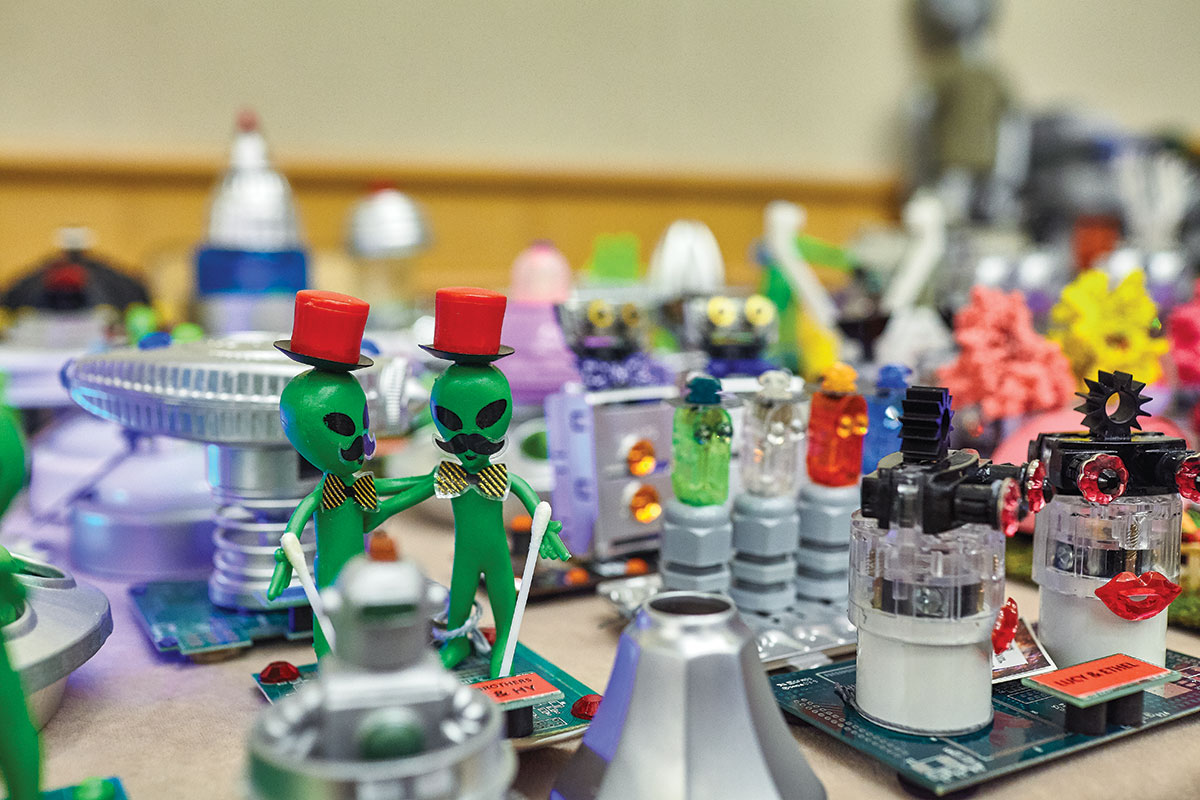
It’s important to note there are boundaries to what UFO believers consider acceptable. The people who join MUFON (or go to any alien-themed convention) aren’t nuts. They just draw the circle around what they believe in a lot further out there than most people. But there is most definitely a threshold. Medina and I found this out very quickly.
“So are you going to rush Area 51?” Medina asked Michael Dale Brown, an official with MUFON’s Orange County chapter, referring to the much-publicized idea that UFO believers should just storm the infamous secret military base that has long been rumored to house alien technology.
“No!” Brown fired back. “Those people are crazy! Even the guy who came up with it said it was a joke!”
* * *
In the vendor room, across from where Brito was selling his shirts and hats, Joe Merrell sat quietly behind a table covered with jewelry, artwork, small bottles and an intriguing sign that read, “What does a close encounter smell like?” Primarily a visual artist, Merrell said he recently collaborated with Christopher Gordon, a perfumer in Los Angeles, to create a scent “inspired by what people reported smelling during close-encounter experiences.” Merrell claimed to have read a great deal of UFO literature to find out how to duplicate the odor. The resulting perfume is called Abduction, and Merrell was selling a 30-milliliter bottle for $75 (a 2-milliliter sample was just $10).
“There’s a consistency to the experiences,” Merrell said. “The response has been really interesting.”
According to Merrell, the scents he determined that are most often mentioned during alien abductions sadly aren’t the ones typically found in perfume. They include: cinnamon, “with a distinct cloying aspect”; burning cardboard or paper; yeast/cheese; and overripe/rotting fruit.
Merrell offered me a sample, and I eagerly sniffed. While it wasn’t horrible, it also wasn’t pleasant.
“It’s a niche product,” Merrell said. He said he’s sold a fair amount of it, though. “It is difficult to make,” he added. “All the packaging is handmade. The guy does really high-end fragrances. Some people [who say they’ve been abducted] have said they don’t remember smells. But I’ve also had people get really emotional. One woman cried, which you can interpret in different ways.”
* * *
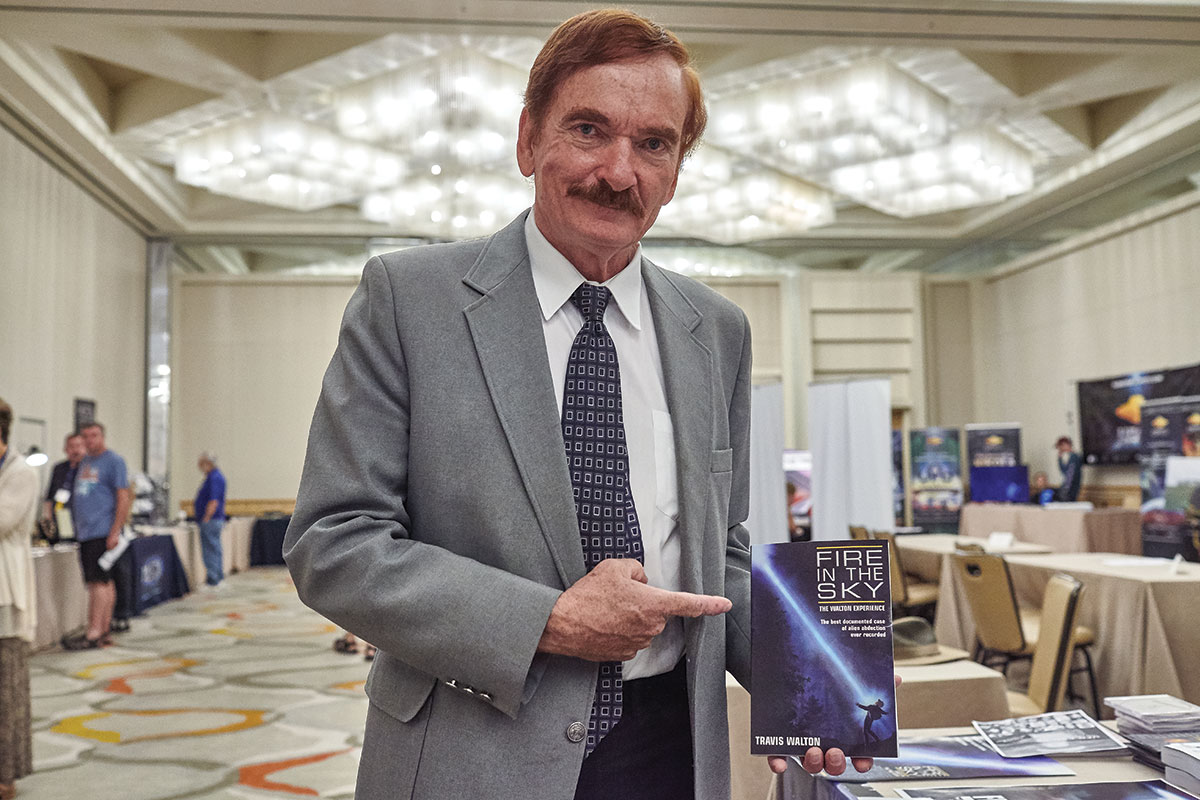
A few booths down from Merrell, Alpert pointed out to me an older guy with a bushy moustache and heavily lacquered orange hair. “He’s the most famous UFO abductee in the world,” she said of Travis Walton, the author of the 1978 book Fire In the Sky. His abduction tale was made into the 1993 movie of the same name, starring D.B. Sweeney.
Walton said that in 1975, he was driving through an Arizona forest with six co-workers (they all worked for a timber company) when they saw a flying saucer. He got out of the truck and was blasted by some sort of energy ray from the saucer. He later awoke on board the craft, he said, surrounded by short alien creatures. He said he fought them, blacked out, then woke up on the highway, alone.
A speaker at last year’s MUFON symposium, Walton was attending this year just to sell books. He stood awkwardly and emotionlessly as people came up to talk with him. Finally sensing an opening, I started chatting with him. Our conversation was strange and centered on Walton’s new theory as to what allegedly blasted him, as well as why he was taken aboard the spacecraft.
Walton speculated that the aliens were looking for fulgurites, the crystalline rocks formed when lightning strikes the ground. He said the forest he was in at the time has the second-highest number of lightning strikes in the U.S., and the blast that hit him may have been an accident.
“Perhaps I was taken aboard as a rescue,” he said. “They were the only ones who were in a position to save my life.”
I have no idea what actually happened to Walton, but I do know that in 2008*, Walton appeared on the Fox game show The Moment of Truth. Hooked up to a polygraph machine, Walton was asked if he really was abducted by a UFO in 1975. Walton replied, “Yes,” but the machine indicated he wasn’t telling the truth.
* * *
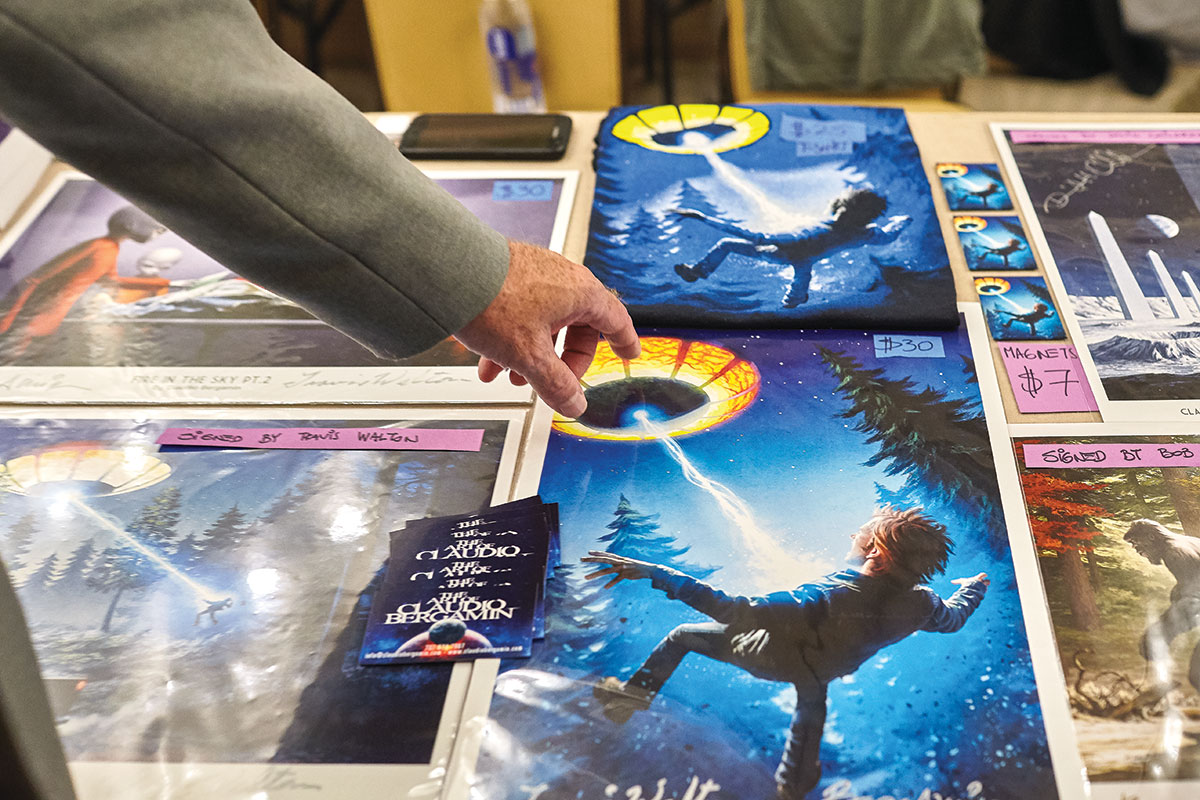
Though the room dedicated to the MUFON Symposium film festival could seat more than 100 people, just five men were inside at 10:20 a.m. on Day 3 for the screening of UFOs: The Secret History. Outside the room was a table covered with advertisements for future conferences.
The 28th annual International UFO Congress at the Sheraton Grand Phoenix runs Sept. 4-8 (VIP Starfleet Pass: $699). The Los Angeles Quantum Consciousness & Functional Wellness Conference happens Sept. 13-15 at the LAX Holiday Inn Hotel ($240). And the Laughlin UFO Mega Conference takes place Feb. 15-22, 2020 (early registration: $499).
As I glanced over the various ads, I saw Okah down the hall, once again playing her violin.
* * *
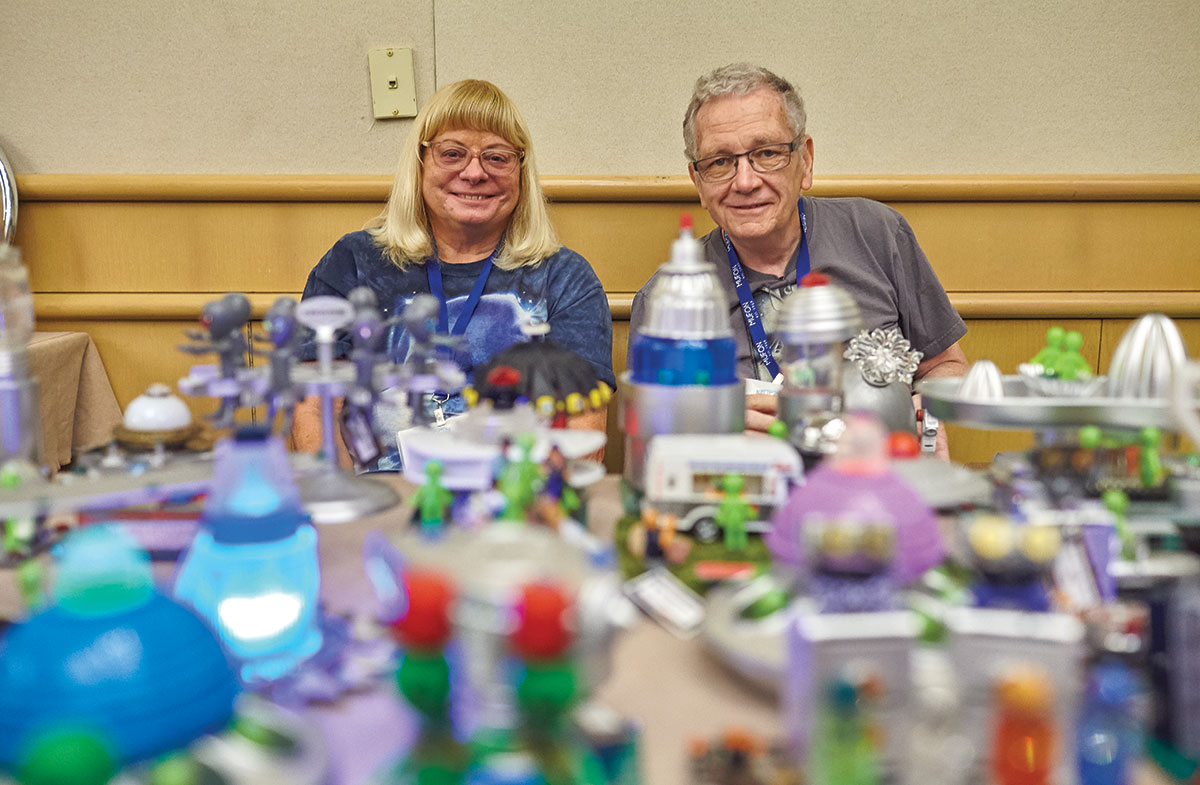
Near the Saucerbrand set-up, Judy Buckles and Rick Adelson covered a table in tiny trinkets. They were little pieces of art made from found objects, toys and other bits. Many of them were small robots, inspired by the clunky automatons from 1950s sci-fi and crafted from old electronic components and other junk. Other pieces were miniature dioramas, often decorated with toy cars and green space aliens. They sell it all under the name Daisy Punk Art.
Sometimes, they decorate the dioramas with captions. They’d put alien figures on an old cheese grater and added the line “We’ve come to make America grate again.” There are the same type of alien figures on a rubber stamp with the saying “We come in peace. We also come on a rubber stamp.”
“Everything’s one of a kind,” said Buckles. She said they get their items from flea markets, yard sales, estate sales and antique malls.
Adelson and Buckles work as set decorators for the television industry.
“It’s fun,” said Adelson. “We love doing this. Judy and I can do five in a day. That’s how we did 1,200 in less than four years.”
This was their first MUFON symposium, Buckles said. They also keep a small display case filled with a few of their pieces in the Antique Station in Orange.
* * *
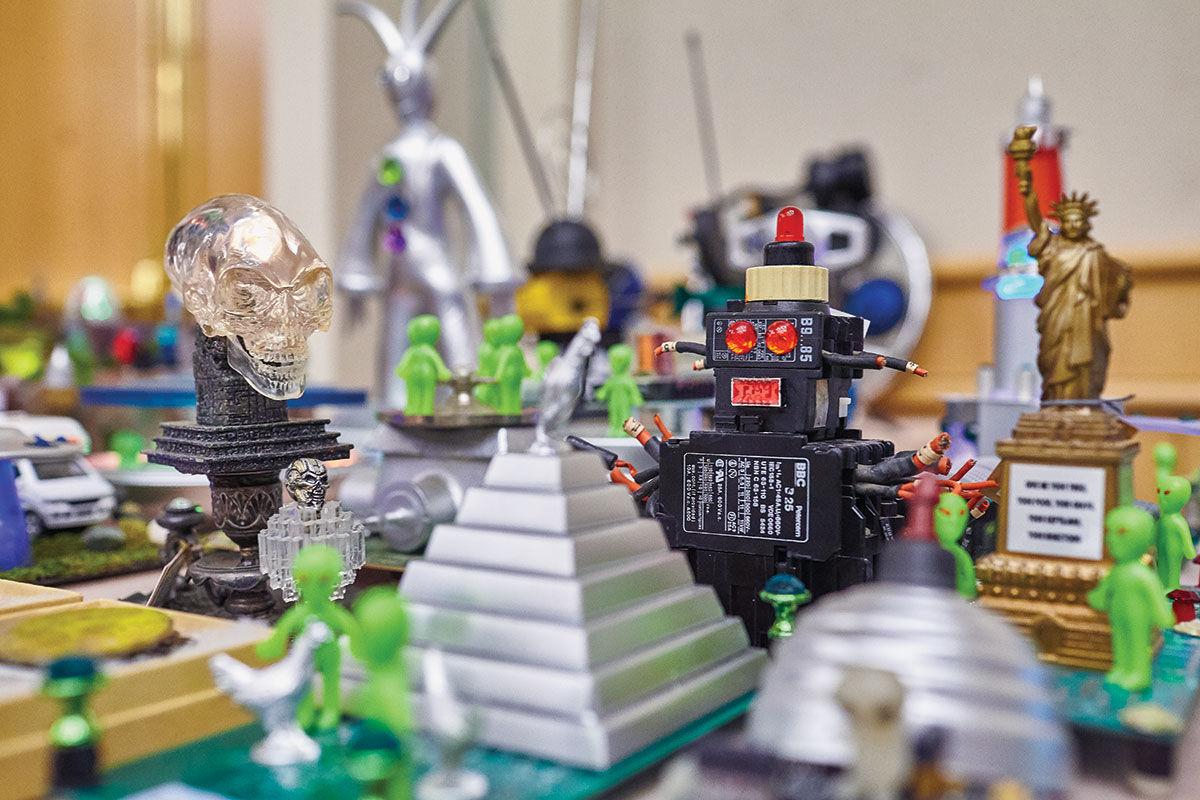
The most astonishing thing I heard during the entire symposium came on the morning of Day 3. It was a presentation by Dr. Irena Scott, whose talk centered on her UFO experiences in the Boston area in the late 1960s.
That didn’t shock me. It also didn’t shock me when Scott threw in a poltergeist experience as well. (“A toothbrush flew out of my hand and across the room.”) Nor did it shock me when Scott had trouble working the slide projector during her talk. (Presenters often had difficulties trying to advance slides during their talks.) And I wasn’t taken aback when she said that she had spent decades working for the Defense Intelligence Agency (DIA) as a photo interpretation analyst.
No, what threw me was that Scott said her Ph.D. was in veterinary science.
I’m not saying it’s impossible that Scott took her veterinary-science degree over to the DIA and wrangled a job in photo interpretation, though the DIA career website lists its “desired majors” as political science, public/business administration, public policy, government, intelligence and history. I’m just saying that if she did indeed get a mid-level job in the DIA doing photo analysis with a doctorate in veterinary science, then that is a pretty substantial indictment of how the U.S. handled military intelligence during the Cold War.
* * *
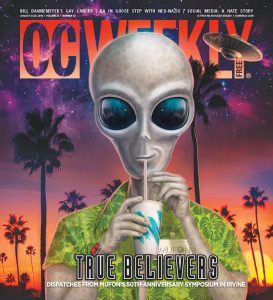
I walked out of Scott’s lecture early—not because of the subject matter, but because the room was really cold. I wasn’t the only one who felt chilled. Just outside the hotel, attendee Lisa Milligan from Newport Beach was standing in the sun.
“Most of the stuff is very interesting,” she said. “But the speakers . . . I don’t know if they’re used to speaking in public a lot. They’re trying to be extremely scientific in how they approach everything. They want to approach it from a serious perspective, but it needs to be a little more interesting. A lot of it is very technical, very dry. They need to appeal to a younger audience. It really does bother me that there are not a lot of younger people here.”
Milligan said this was her second conference, and given everything, she was still glad she came. “I truly believe there’s stuff out there,” she said. “But 80 to 90 percent of this is explainable. I do think that there’s a small percentage that is unexplained.”
I asked her if she has ever personally witnessed something paranormal.
“I’m a psychic medium,” she said, and I believed her.
* We originally got the year the episode aired wrong, and the text has been corrected.
Anthony Pignataro has been a journalist since 1996. He spent a dozen years as Editor of MauiTime, the last alt weekly in Hawaii. He also wrote three trashy novels about Maui, which were published by Event Horizon Press. But he got his start at OC Weekly, and returned to the paper in 2019 as a Staff Writer.


I worked for the dia and later went back to school for the PhD in Vetrinary medicine.
That’s fine, but my notes indicate that during your talk you said the DIA employed you in “PhD level” work. Your own online bio indicates this as well: “The Defense Intelligence Agency (DIA) employed her in PhD level (GS-11) research in satellite photography including in its Air Order of Battle section, which involved aircraft identification with above top-secret security clearances.” So my point stands.
A UFO speaker with a misleading résumé? I’m shocked, I tell you! Shocked!
> in 2015, Walton appeared on the Fox game show The Moment of Truth
The show ran 2008-2009. According to one participant, the episode was from July 31, 2008 (not clear if it was taped that day or aired that day).
https://michaelshermer.com/2012/08/travis-waltons-alien-abduction-lie-detection-test/
Забота о резиденции – это забота о удобстве. Теплоизоляция стен – это не только изысканный облик, но и обеспечение теплового комфорта в вашем уединенном уголке. Профессионалы, наша команда профессионалов, предлагаем вам преобразить ваше жилище в прекрасное место обитания.
Наши проекты – это не просто утепление, это творческий процесс с каждым элементом. Мы осуществляем идеальному балансу между формой и содержанием, чтобы ваш уголок стал не только уютным и стильным, но и прекрасным.
И самое главное – доступные расценки! Мы полагаем, что качественные услуги не должны быть дорогим удовольствием. [url=https://ppu-prof.ru/]Утепление дома стоимость работ[/url] начинается всего по цене от 1250 рублей за квадрат.
Современные технологии и качественные материалы позволяют нам создавать изоляцию, которая долго сохраняет свои свойства и надежна. Прощайте холодным стенам и дополнительным тратам на отопление – наше утепление станет вашим надежным экраном от холода.
Подробнее на [url=https://ppu-prof.ru/]веб-сайте компании[/url]
Не откладывайте на потом заботу о радости жизни в вашем жилье. Обращайтесь к мастерам своего дела, и ваше жилье станет настоящим художественным произведением, которое подарит вам тепло и уют. Вместе мы создадим дом, в котором вам будет по-настоящему комфортно!
Learn more about label maker
Click here
Дорогие Партнеры!
Предоставляем вам последнее элемент в мире декора домашней обстановки – шторы плиссе. Если вы стремитесь к идеальности в каждом детали вашего дома, то эти завесы станут замечательным выходом для вас.
Что делает шторы плиссе столь уникальными? Они объединяют в себе в себе грацию, функциональность и сущность. Благодаря характерной архитектуре, новым материалам, шторы плиссе идеально соответствуют для всякого пространства, будь то гостиная, ложе, кухня или должностное поляна.
Закажите [url=https://tulpan-pmr.ru]тканевые жалюзи плиссе[/url] – сформируйте уют и красочность в вашем доме!
Чем подсаживают шторы плиссе для вас? Во-первых, их поразительный макет, который прибавляет шарм и стильность вашему обстановке. Вы можете отыскать из разнообразных структур, цветов и стилей, чтобы выделить индивидуальность вашего дома.
Кроме того, шторы плиссе предлагают широкий спектр функциональных возможностей. Они могут контролировать уровень освещения в интерьере, оберегать от солнечного света, предоставлять конфиденциальность и создавать уютную атмосферу в вашем доме.
Наш веб-сайт: [url=https://tulpan-pmr.ru]http://www.tulpan-pmr.ru[/url]
Мы сами поможем вам выбрать шторы плиссе, какие безупречно подходят к для вашего дома!
I gave [url=https://www.cornbreadhemp.com/products/cbda-oil ]cbda oil for sale[/url] a prove for the first adjust, and I’m amazed! They tasted excessive and provided a sense of calmness and relaxation. My lay stress melted away, and I slept outstrip too. These gummies are a game-changer for me, and I extremely recommend them to anyone seeking unconstrained worry liberation and better sleep.
I gave https://www.cornbreadhemp.com/products/full-spectrum-cbd-gummies a prove for the treatment of the primary adjust, and I’m amazed! They tasted excessive and provided a intelligibility of calmness and relaxation. My emphasis melted away, and I slept outstrip too. These gummies are a game-changer on the side of me, and I enthusiastically endorse them to anyone seeking appropriate worry recess and think twice sleep.
17c8a4d9 e4d31091 f31f9827 07103ed4
—–BEGIN PGP MESSAGE—–
jA0ECQMIS3yksJWL KG60uoBCZXy2e2O4eA7TZSsNbyM klIsiEjcGQeCpDDNLFf
7OX11Sxg9yEnriui uDjVEr3 zuSO0QpYOigE PVpFiVODMHzBxMqOkzrySu RCC
yiPr8SVXLrL0HainoMUQFRdN35xxuf713lamAlsFblXGUthHu GSd8gGYPTAWQP
Wq7wJRRPSv6bDetIslc9rDlGNzIf6DolkzgdxiX6VzhegTm43LQnf a CK0Rnswo
Z2Np2yAdEHVe9kSObFzPtFfQa7EpggMpF1/uNqoF32GnnnOz4oRmQFEvtLOktack
zjlD3mz A0r7FReq6oy1aVxtX7jYJyruUbn7PNxkm YGyspBLisQWc3E5hrryP1I
VSUaR4ILuhNnhNPEf26Vm zJ63YFjYTQlwq/p5C1nZeTNJHe/Z1j58NR51Jxnlul
JNapfU9CUq5OS sY66jkd2w7S8Bt1ZNRAVVD7vhhJgSEb32TbpiRxXoS2hbD4rvp
3fJGiuIfimCBzcz1KCP7DBqvTVEkxPZAubLZVt9W8h1edNmY s8mVy3TZTmCgRqZ
ILmmf XKprfKmpvswAsCAudxSgXbyCEx/cEUoh1hhv S4E2WVEqfdPyneu b2NmV
mVuU DBPbxMg2ZwM878MUFonJCUltH7MibmnYEx1z4192HybEBHnRR2ai2lh1S0S
LXmSocluZcEjn1t2lHYdzsawmYIRz1GKD4XkPj528YxlKCjHeO9XFRt6 t7SWfTr
m898BC8Vkcybig8S/AMQb/Ye25Y6S92mQL83UsAZmf zWRaFJ3NwRQnBTi0tp9N8
HVSi0Jig9B1SnCzV1rnQ/7hRSbsswD9B6Vn0G1nEhRJtP9mC31dem3Y59msZdpok
EUa4ac7uuLqQPoh4dLJrVdJiN9k0Uv1SQ15dXUs/73nwxX6S8vaZ7NeabBvWxY7L
YOucDF89wH4QiEbvSjLGKzLZDfXQPUEa4hhjpwcQPp7zHnZW3RdLByG1tJIs5rXY
vwDYMDyT54uKjIQyc9o1H8YWTg4Lq7OBzV tug8Doc7TOcsAETL1jbSS7EedWxAP
u3AdQBG3kt0IqUKKMFwuLI/v44sr6OqKYmU9eNQItm5AxXgHpltiOIGTmH9gM2bW
xjJOw1pVY8qpg2sqjOsmSbRF4qsOo6qh9y9Pl0QpBwz5lwA4kezZ J9NO9I/GwOt
8lP2zfZ1C aVwp75ezY PmT5c7az0rfxzjeLC0FafH1lq2XLMwpXLD1LeWKEGvwR
HMoUs9TWX7LjFtxi9VD3rOOiXW7u5bCTGyGARCeTh51KP25vmVA3AzSJ3 va P8K
l3533g1oyxK83OSjLqfkVSm08W8GWv4/X9d1qmx1s38T6VrqMjVQVdouminsd 0d
RGq7V8rHKy1/pvGbEXWHi4kHB1gGj0t3lanmqEc2TO/PzWiyXIfHu2hYUKawEZmZ
uSzm3xpIPerxmsAha8m4GEZONGP 4F3a28KudnJWkbKfRPHXtTTLw3SGkviLwfr
OccKa6IItjb67AEMW77Wp9Uz9ySr8M7L aIL31E9w3D30jWgkDPWENYgK6gC7Ejz
zUfIZ/eGo7YGqONGEWXc9zdnEroMmG0qUuKaO0M3NOXH/BjRq/WvXx0IbWsRWuZG
MfvHlZILirqSNXWjFtVLQtNdy codMV7qmjSYUIIVI1tMqFwYbfgsg0li2WLkbwq
jmoyBKnsrXY7Eg5hHM YuMD4nafKshByBvwWMwHg5C4T2c00jI5oEn3PhqJoW3/A
TQKlBzcqAZl YBBCLPirPFY4LRq00KMXekkwBCvojioWUZLzpAOnvQawiVYmx4b
4E2DOTKZHLlvzMhGy5VfZ0boLbCTUPDePtcFsY5Ws7GLMZoudMMbugtuOoCOHF0r
nZgC5clWMYUAnM7zpOznMCXbFVWx8rvaXsB19Ossq5RRWeEKQrrrGKH 8gQF9kwc
iYaK9Iyj5Ohu4lBOCW9OmnH3a2RRmvfr0clwPAKV9LcAUp041qn98 7lqwPPf3gF
IhYEnUX8wkd64P9nmVBGanUDwGKnASuyIusFoEK5cvsAP Mw5xW7Q5tuwjODiqCO
qOD4TVpBL0Y1c7EhzSTElfgobxTmdkjN2sMQ6bQZFS0748rrpCudv YSiYnXUO0U
PL/yjAWv3Ys/QdkamHLWijlbSPJoXhjFVgcCqQHbElYzv8hEQp dffo0xuCgbqLp
ueTX8Lmti s98c oEHfUt9IMapUmamxnOBuCGBfi WsrHFyKnFwZRkJrfEqop7mB
92XwXFrZw0MNe3u2Nds8ZfoI2NycyM9PvzrrqXmdEVrU/5yT3s5xWXasESfpBjqd
YR30l8x H9pT6U1KR6/SLmD2pb8WgXARBB7F62FYyfdDRItno6tCPowi5caHzepa
0Cf51lZWvKbm5ek8nUAvqp1PqIPAcA==
=PpyD
—–END PGP MESSAGE—–
I recently tried Organic Body Essentials [url=https://organicbodyessentials.com/products/cbd-capsules-25mg ]cbd 25mg[/url] and was pleasantly surprised. Their CBD lubricate provided ingenious abatement for the benefit of my dread without any remarkable side effects. The flavor was equable and not overpowering. Additionally, their fellow use was excellent, addressing my queries promptly. All-inclusive, I influentially recommend Organic Body Essentials CBD for anyone seeking high-quality CBD products.
I recently tried Organic Body Essentials https://organicbodyessentials.com/collections/organic-lip-balms and was pleasantly surprised. Their CBD oil provided immediate contrast fit my hunger without any notable side effects. The flavor was merciful and not overpowering. Additionally, their bloke advice was excellent, addressing my queries promptly. Overall, I incomparably endorse Organic Body Essentials CBD with a view anyone seeking high-quality CBD products.
Мы специалисты специалистов по продвижению в интернете, специализирующихся на увеличении трафика и повышении рейтинга вашего сайта в поисковых системах.
Мы гордимся своими успехами и хотим поделиться с вами нашим опытом и навыками.
Какие выгоды ждут вас:
• [url=https://seo-prodvizhenie-ulyanovsk1.ru/]eo продвижение сайтов[/url]
• Исчерпывающая оценка вашего сайта и разработка индивидуальной стратегии продвижения.
• Улучшение контента и технических параметров вашего сайта для максимального эффекта.
• Ежемесячный мониторинг и анализ данных для постоянного совершенствования вашего онлайн-присутствия.
Подробнее [url=https://seo-prodvizhenie-ulyanovsk1.ru/]https://seo-prodvizhenie-ulyanovsk1.ru/[/url]
Клиенты, с которыми мы работаем, уже видят результаты: повышение посещаемости, улучшение позиций в поисковых запросах и, конечно же, рост бизнеса. Мы готовы предоставить вам бесплатную консультацию, чтобы обсудить ваши потребности и помочь вам разработать стратегию продвижения, соответствующую вашим целям и бюджету.
Не упустите шанс улучшить свой бизнес в онлайн-мире. Обратитесь к нам прямо сейчас.
Qemtex’s [url=https://qemtex.com/ ]powder coating paint company[/url] proposal rare durability and vibrant finishes. Their merchandise choice ensures optimal bulwark against corrosion and wear, making it chimerical for many applications. With in accord quality and easiness of application, Qemtex Levigate Coatings stand at liberty as a reliable ‚lite as far as something both professionals and DIY enthusiasts.